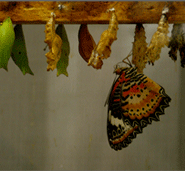How do I begin? A question all too familiar to most of us of the creative persuasion or, indeed, of any persuasion, when we are starting something new. And it is this question that appears to plague Maya Krishna Rao’s character throughout her solo performance of Ravanama. Rao plays an actor preparing for the part of Ravana, the mythological ten-headed rakshas from the Ramayana.
The actor struggles to come to terms with her new role: she moves in and out of an almost trance-like state in an attempt to transform herself into her ten headed character. It is as if a battle is taking place within her as different facets of Ravana are revealed. The different facets contradict and contend with each other just like Ravana’s ten heads,which are said to have represented different, often opposing, emotions. Sitting in the audience watching this personal battle unfold is an uncomfortable, voyeuristic experience of watching someone else’s private torment laid bare for all to see.
The bare, dark stage with minimal props and a stark spotlight that follows Rao enhances the actor’s frustration and growing panic. The torment of the creative process sends her into a state of near hysteria: Rao’s wide eyed, panicked expressions, her guttural voice and staccato yet graceful movements give us a glimpse of how the art of creating something and getting something right can push a person to the limit— a Lakshman-rekha of the artistic process, so to speak.
The music to which Rao’s character explores the different aspects of Ravana varies wildly – another indication of the confusion and contradictions in the mind of the actor. From traditional Indian classical music to Pink Floyd, each facet of Ravana has its own distinct theme. Rao even throws in Michael Jackson’s ‘Bad’ as the actor does her own rendition of the moon-walk on stage – a clear crowd pleaser judging by the hoots and applause from the audience! Besides its comic relief however, it contemporizes one of the oldest epic stories and makes it new.
I associate Ravana with fireworks, candy-floss and children whooping for joy. His name brings back memories of childhood trips to the local fair ground on Dussehra to watch a towering wooden version of him and his ten heads go up in flames. But Rao shows through her play that he was a much more complex character than just the evil rakshas who Ram defeated in the Ramayana. We see glimpses of Ravana the musician, the Shiva devotee , the intellectual and the longing father, amongst others. But, even as it is clear that Rao has meticulously explored the different representations of Ravana, one leaves the theatre thinking less of the fascinating ten headed rakshas and more of the universal complexities of the creative process. And of the question that plagues us all – where to begin?
By Lara Sinha, a media anchor living in Delhi.
Editor's Note.
Per-form: to carry out with adherence to a prescribed style. Herein lies the bewildering aspect of performance art: that whilst it appears to subvert the Aristotelian pyramid of theatre, devoid of narrative or apparent technique, it also subscribes to it.
Read MoreAlso in this issue
Illusion: Seeing Beyond Seeing
Meaning: In Search of Significance.
Melody: A Different Tune
Rhythm: Ordering Time

.jpg&w=585&h=350&q=100)
.jpg&w=585&h=350&q=100)






